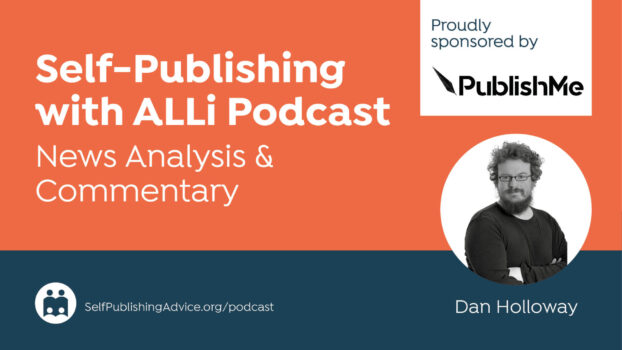The beginning of the year is a perfect time to set goals and plan actions, especially if you're an author. While most businesses write a business plan, it's not always a consideration writers make. Tetiana Bek, from ALLi partner member MiblArt is here to explain how to create one and as well as the goals in it.
What You Need to Know Before Creating a Business Plan
 When you regard self-publishing as a business, you need a business plan. It'll enable you to always stay a step ahead of your competitors. So what do you need to know before coming up with a thorough business strategy?
When you regard self-publishing as a business, you need a business plan. It'll enable you to always stay a step ahead of your competitors. So what do you need to know before coming up with a thorough business strategy?
Indicate a Mission Statement for Your Business
You should try to consider every book as a product with its philosophy and goals. Initially, a mission statement is your vision of the final version of the book.
Here is how you can create an effective mission statement:
- Establish your identity and state, who you are as a writer:
I'm a crafter of the new fantasy world with paranormal events occurring in the modern metropolis.
- Try to point out the characteristics of readers interested in your writing:
My readers are keen on diving into the unreal world and experience adventures, love, and loss with the characters of the novels.
- Celebrate your originality and tell about your uniqueness:
I long for presenting readers exciting worlds created by my imagination and crafted with words.
Try to be short and simple yet remain creative.
Analyze the parts of your mission statement and write down actions to complete each of them in order. Let’s create a roadmap for your writing career with the SMART goals technique.
How to Create SMART Goals for Your Writing Career
SMART is an acronym, which stands for Specific, Measurable, Achievable, Relevant, Time-Bound.
SPECIFIC
Make it as detailed as possible to avoid ambiguity. Instead of saying, “I want to write a book,” you should set a goal, “I want to write a 300-word mystery with a female protagonist.”
The five W-questions technique endows your purpose with clarity and conciseness.
- Who: Who is involved in this goal?
- What: What do I want to accomplish?
- Where: Where is this goal to be achieved?
- When: When do I want to achieve this goal?
- Why: Why do I want to achieve this goal?
Also, you may add the sixth question to be even more specific:
- How: How do I want to achieve this goal?
MEASURABLE
Add numbers to track your results and know how close the finish is. Moreover, it’s good to divide the whole process into short sections and decide on the measurements.
- How much?
- How many?
- How often?
ACHIEVABLE
Reassure yourself that your goal is attainable. Plenty of people are trapped by their desire to reach impossible targets.
To make sure that your goals are both achievable and challenging, ask yourself these questions:
- How realistic is this goal?
- What should I do to accomplish it?
Take into account different factors, such as budget, competency, time, and others, that may influence your success.
RELEVANT
Think about the benefits you want to get accomplishing this goal. Is it worth your efforts and time spent on it? So, you should estimate how your goal is relevant to the overall business plan.
- Is the aim worthwhile?
- Is it the right time to reach the target?
- Does it match needs and efforts?
- Is it applicable in the current situation?
If you've given definite yes-answers to all the questions, then go ahead accomplishing your goal.
TIME-BOUND
Set a realistic deadline. If your target has no time frame, you're unlikely to achieve it. Time frames keep you motivated to complete your tasks.
- When I want to finish the task?
- What is the deadline for each stage?
How to Use Smart Goals
As we’ve already discussed what the SMART goals are, let’s analyze it together. Imagine that you need book cover design services. Here’s how you can break the process into smart goals.
Goal |
Write down the goal |
I need to design a cover for my latest book. |
Specific |
Specify the goal: who, what, where, when, why, how |
|
Measurable |
Indicate measurements for the goal: how much, how many, how often |
I need to find a person who can create a customized ebook cover design for $100-150. I want to see the first results in 7-10 days. |
Achievable |
Reread the points above and think about how achievable the goal is. What is your motivation? |
Everything seems realistic.I need to create a list of sources where to look for a designer. After comparing their portfolios and prices, I can hire a person who will start creating a cover. I want to publish my ebook in the first decade of February. |
Relevant |
Is it the right time to accomplish this goal? Does it match needs and efforts? |
When the holidays are over, I can afford to spend some money on designing a cover for my new ebook. |
Time-bound |
Set time frames for milestones |
|
Now it’s your turn to write and track your SMART goal!
Download MiblArt Template for SMART goals
Step by Step Process of Business Plan Creation
Now you’re all set and ready for creating a business plan. A business plan usually includes the following blocks: buyer persona portrait, competitor analysis, value proposition, revenue streams, key activities, distribution channels and partners.
Let’s review each of them in more detail.
How to Create Your Ideal Reader Portrait
Always keep in mind your potential readers when writing a book. There is more chance that your writing will satisfy their expectations. Here is how you can analyze your target audience:
- Identify your genre to make the target audience aware of the concept of your writing.
- Find out the demographics, reading habits, values, and challenges of the target audience.
- Write down the reading preferences and interests of your ideal reader
- Select out your ideal and potential readers. Several persona profiles give you more opportunities for improvements in self-publishing.
Now it’s time to analyze your competitors and find out how you can be different.
How to Conduct a Competitor Analysis
A competitor analysis helps you to know the strengths and weaknesses of other writers in your genre.
Where to start?
- Define the top ten best-selling authors in your genre. You can find them on Amazon and other book-selling platforms.
- Analyze their websites, social media profiles, and design of their books.
- Pay attention to all types of content they provide (blogs, seminars, podcasts).
- Learn how they engage with the audience.
- Focus on their pricing, recommendations, and reviews
This information opens up opportunities for improvement and reinforces your positioning on the market.
How to Create a Value Proposition
Value proposition is a promise you give your audience about your business. It is a statement that affirms your difference from competitors.
If you’re an indie author, it may sound like:
“You’ll discover the world of fantasy unknown before,” or
“Follow breathtaking adventures in every book of the X series.”
Use your creativity to find the value proposition of your writing.
How to Come up with Book Distribution Channels
There are two types of book distribution channels: ebook and print book. You may choose either one of them or both. It’s up to you. Yet, you have to understand their differences and principles of work.
Regarding online distribution, you can work directly with:
- online retailers (Amazon KDP, Apple, Kobo, Barnes & Noble, etc.),
- ebook distribution services (Smashwords, Draft2Digital, and others).
When you create your marketing strategy, you may include both types of book distribution or choose only one option. Test them to know what helps you enlarge sales and awareness of your writing.
How to Define Revenue Streams
Like any business, self-publishing has to bring in income. That's why you should compile the list of sources you want to distribute for money and free of charge.
Public speaking, coaching, online courses, and corporate sponsorship are great ways of extra income. However, they require some knowledge and competency.
Your Key Activities as an Author
It’s essential to track your progress. You should write down your plans and ideas — arrange your day, schedule your week, and organize your month.
Check your plans and make corrections every day to make sure that you follow the desired direction.
How to Build Partnerships in the Publishing Industry
A partnership allows an indie author to expand their audience and get new subscribers. You can convert the list of your competitors into partners. Make sure that your audiences match, share similar interests, and possess common values.
Here is how you can partner with other authors:
- Co-create books
- Organize different events
- Cross promote each other
- Write a guest post for their blog
- Write reviews for each other’s books
Wrapping Up
All in all, a business plan is the key to success for an indie author. As you put everything to paper, you can control the process, improve the shortcomings, execute more tasks and reach your aims.
As a bonus, we’ve created Business Canvas Template that will help you to create an effective business plan step-by-step. Use it to prosper in self-publishing and book marketing!
Find out more about MiblArt on their website, Facebook, and Instagram.
Structure your 2020 writing business with a plan and SMART goals from @MIBLart #indieauthor #selfpublishing #IARTG #ASMRG #writingcommunity Share on XOVER TO YOU
Have you written a business plan this year? What sections did you include?
If you enjoyed this post, you might like these from the ALLi archive:
https://selfpublishingadvice.org/ten-business-models-for-indie-authors/




